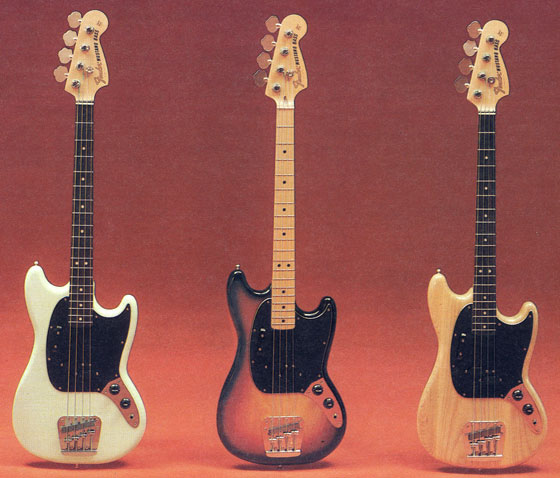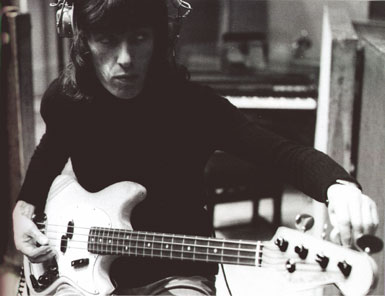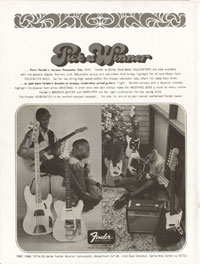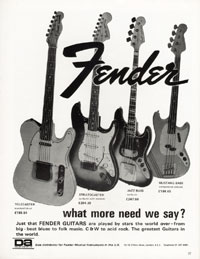


The Fender Mustang bass was a short scaled (30") four string bass, produced at Fender's Fullerton plant, California, USA from 1966 until 1983. It was one of the first new instruments of the CBS era, and companion model to the Mustang guitar. Like all Fender guitars up until that time it was a simple bolt on neck, solid body with electronics mounted to the scratchplate.
With its short scale, the Fender Mustang bass was aimed at guitarists dabbling at bass, and students; but nonetheless is a great playing, solid feeling instrument, with good quality components. It certainly does not feel like an entry level guitar. Previous basses, like the Precision and Jazz had a longer 34 1/2" scale. But the Fender Mustang bass was not the first 30" scale bass produced by the company (the Bass VI and Coronado bass were also 30"); nor the last, the Mustang would be joined by the Fender Musicmaster bass in 1970.
The Fender Mustang bass was first included in the July 1966 Fender price list, listed at $189.50; compared to $223 for the Fender Precision, and $271 for the Fender Jazz bass. Left handed models were available with a 10% premium.
The following description is taken from the 1969 Fender Lovin' Care catalog
The Mustang Bass is ideal for the student and musician with short reach, because it features 30" string length and smaller body. Solid bass tone is achieved through the use of a split pickup positioned for maximum string response. Each pickup section may be adjusted for custom string balance. Tone and volume controls are conveniently located and provide wide tone variation. Individual bridges for each string are adjustable for length and height. In addition, each has its own string mute allowing the player to control sustaining duration to suit his requirements. A finger rest is placed to give maximum support to the hand. The truss-rod reinforced neck is slimmed down for fast action and has 19 frets. Available in red, white or blue finish.

The Competition Fender Mustang basses were functionally the same as any other Fender Mustang bass, but with a new look. From May 1969, price lists refer to the Competition Mustang; a red, orange or burgundy bass (actually blue), with stripes across the top corner, akin to the classic sports car; otherwise the same as older versions of the Mustang.
Have a listen to a Fender Mustang bass (more Mustang soundclips here).
Below: Fender Mustang basses from the 1976 Fender catalog: in White, Sunburst and Natural finishes. Note the black pickguard typical mid to late seventies Mustangs. The Sunburst bass also has a maple fretboard with black dots; a feature that would become increasingly common.


The Fender Mustang bass follows the same serial number rules as any other Fender bass; looking it up in one of the many online sources will give a broadly accurate date (although there are certainly exceptions).
The components, like most guitars, changed over time. The location of the thumbrest and serial number, the scratchplate and fretboard material, and the specific headstock decals can all help in pinning down a date, as can codes on the bottom end of the neck and the potentiometers - useful if serial numbers themselves can not be read.
Some of these changes are listed in the timeline below, but also have a closer look at the catalogue pages and photosets which show typical basses for each year.
1964: The Fender Mustang guitar is launched
1966: Production of the Mustang bass starts at the Fullerton factory, California. United States list price $189.50 (7/66). Initially available in red, White and blue finishes, left handed 10% extra. Early features include a thumbrest positioned below the strings. The bass is included in the 1966-67 Fender Catalogue
1967: List price $189.50 (6/67, 10/67)
1968: List price $199.50 (3/68, 7/68). The 1968 Fender Catalogue lists Red, White and Blue as finish options.
1969: May price list mentions Competition finishes (Orange, Red and Burgundy), list price $229.50 (5/69)
Many, but not all 1969 Competition Mustangs had a matching coloured headstock, rather than natural maple.
See the 1969 Fender Mustang part list
1970: Finishes available are Sunburst, and three Competition colours (Orange, Red and Burgundy). See the 1970 Fender catalogue.
Finishes as above. List price $239.50, left had $262.50 (4/70)
1971: Finishes and prices as above (1/71)
1972: Finishes and prices as above (2/72), though changing to Sunburst, White and just two competition colours (Red and Burgundy) in the 1972 Fender Catalogue. Gradually over 1972/73 the thumbrest position changes to be above the strings.
1973: Prices and finishes as above (6/73)
1974: Finishes listed as available are Sunburst, Olympic White, Black and Walnut. List price $265, left had $290 (12/74)
1975:
1976: Serial numbers are now a decal on the face of the headstock rather than being stamped into the neckplate.
See the 1976 Fender Mustang part list
1977: Finishes available are Sunburst, Blond, White, Black, Natural and Walnut (11/77)
1978:
1979:
1980: Finishes available are Tobacco Sunburst, White, Black, Natural, Antigua and Wine. Left handed basses are available in Sunburst only. (2/80)
1981: Only two finishes are listed in price lists, Black and Wine (6/81)
1982: The Mustang bass is not listed in the 1982 catalogue or price lists
1983: Production ceases entirely at the Fullerton plant.
Electric bass advertisements originally published from 1968 onwards. Click on the images for larger copies. Check out other vintage Fender advertisements

Fender Mustang - Pick A Winner (1968)
...From Fender's famous Telecaster Trio. (left) Fender 6 String Solid Body TELECASTERS are now available with the popular Bigsby Tremolo Unit. Adjustable pickup and adjustable dual bridge highlight...
[more]

Fender Mustang - Fender. What more need we say (1971)
just that Fender guitars are played by stars the world over - from big-beat blues to folk music, c&w to acid rock. The greatest guitars in the world
UK Dallas Arbiter (Fender distributor) fe...
[more]
Notable users include Bill Wyman of the Rolling Stones and Tina Weymouth of Talking Heads - check out the clip of "Psychokiller" below from the BBC's Old Grey Whistle Test in 1978. Tina Weymouth's bass is admittedly upgraded, but she gets a superb tone from it.
$4000
$4395
$2650
$2999
$3499
$2500
$1995
$2295
$2295
$749